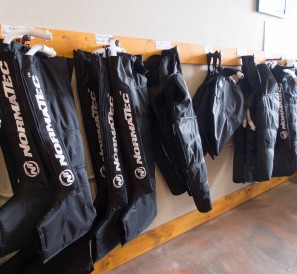 Last month I discussed the nutritional aspects to help recovery from injury and exercise-induced muscle damage. In this Part 2, I’m going to examine the modalities available to facilitate recovery, timing of their use and what’s best for a dude vs. a woman. The purpose of this review is to allow you to recover faster, garner training adaptations a bit quicker; thus allowing smarter training and fitness gains.
Last month I discussed the nutritional aspects to help recovery from injury and exercise-induced muscle damage. In this Part 2, I’m going to examine the modalities available to facilitate recovery, timing of their use and what’s best for a dude vs. a woman. The purpose of this review is to allow you to recover faster, garner training adaptations a bit quicker; thus allowing smarter training and fitness gains.
As I mentioned, right next door to my office a new niche recovery lounge has opened up (RechargeSportSF.com) attending to the most under-emphasized aspect of training: Recovery. The focus at places like Recharge is to offer bigger ticket items for recovery such as compression boots, water circulating compression for cooling-compression, cold laser therapy, and some EMS (electrical muscle stimulation such as the MarcPro).
A question often asked is why make these available to the general public? Why not just reserve them for the top end professional athletes whose livelihood relies on specific performance outcomes? Primarily because these modalities work and they should be available to everyone who trains hard, works hard, and then has to face the stress of real life (read: kids, job, family, travel, mortgage, Interbike…).
In the first few minutes of coming to the end of a key training session, first consider active recovery (e.g. easy 10 min spin, low heart rate). Active recovery is especially advantageous when there are two sessions in a day, or an evening preceding a morning session (e.g. 1 -12 hour apart). Many studies have shown that an active recovery allows more rapid return to resting blood lactate levels, compared to passive recovery, by enabling quicker return of intramuscular pH to baseline. Active recovery is beneficial for both men and women. However, it appears to be more critical in women. There is a greater decrease in arterial blood pressure post-exercise in women, reducing blood flow to below baseline levels with passive recovery which limits muscle blood flow and nutrient exchange at the muscle cell level. Whereas active recovery mitigates this drop in blood flow by maintaining venous return and subsequent blood flow to the muscle; enhancing nutrient exchange and muscle repair.
In addition to blood pressure changes, and blood flow fluctuations after exercise, there is also the time-lapse for core body temperature to come back to baseline. A rise in core temperature during exercise is a normal consequence, but with an elevated core temperature, more blood flow is diverted to the skin to offload the heat, reducing central blood flow (eg to and from the muscles for recovery). This time-lapse of elevated core temperature to baseline allows inflammation and metabolic waste to linger within the muscle tissue, prolonging a stressed state. This is where some of the modalities at places like Recharge can help.
Compression using the NormaTec boots and sleeves work on a principle of pulse compression; working with the body’s natural muscle pulse and blood flow control to provide compression-release deep into the musculature. This effectively reduces blood, then floods blood into the muscle, the “flood” significantly increases tissue oxygenation, nutrient exchange, and metabolic waste removal. The body naturally does this over time, but using the pulse-compression rapidly enhances return to baseline, aka faster, effective recovery. There is a sex difference for compression use as well. Women’s blood pressure responses post exercise are different from those of men’s. Women’s core temperatures take longer to come back to baseline, therefore women have a greater cutaneous vasodilation response (increased skin blood flow) with a greater drop in arterial pressure (decreased central blood flow for circulation) as compared to men. In a timing scope, using something like the NormaTec system would be ideal for women within 30 minutes of finishing a session, whereas men can wait a bit longer (60-90 minutes) to garner the benefits.
“If women tend to have a more elevated core temperature post-exercise than men, wouldn’t they be better off with cooling and compression..?”. Yes. And this is where something like the GameReady system can help. GameReady uses wave-like compression but the wraps use circulating cool water. The cooling-compression combination will help counteract the vasodilation response women have, and “push” more blood from the skin back into central circulation, enhancing blood flow to the muscles. The cooling-compression of the GameReady system is also ideal for joint inflammation or soft tissue injury that involves swelling; regardless of sex.
What if there is no recovery lounge near you and you are looking for a bit of an extra recovery boost at home? One popular method of acute recovery is jumping in a cold lake or stream (or ice bath), but the research is equivocal on the effectiveness of this method. Infact, it may actually increase muscle soreness over the following 36 hours. The theory is that the cold water will constrict blood vessels and reduce inflammation in the muscle; but the cold water against the skin is a surface effect- e.g constriction of the surface vessels, which does shoot blood back into circulation, but it does not affect the muscle or temperature of the muscle. Investing in small Electrical Muscle Stimulation devices may be better option for you. There are several on the market, ranging in quality and price. The two most talked about in the endurance set are the Compex and the MarcPro. They both work on the principles of electrostimulation: a simulated neural input to contract a muscle. The Compex uses a traditional EMS program that is ideal for muscle re-education via the nervous system: a strong, static contraction with a sudden release; whereas the MarcPro utilizes a decaying wave form technique: a moderate contraction with a slow release. The decaying wave form is more attuned to muscle recovery by allowing fluids to flow in and out of the muscle cells without undue fatigue often experienced with the traditional EMS program. Both are great at simulating active recovery and enhancing blood flow to tight, bound areas of muscle; but if chronic pain is an issue, the MarcPro may be the better option for you.
Regardless of the availability of recovery modalities, one key modality everyone should employ is mobility. Mobility is working the joints functionally to reduce stiffness and imbalances we find so prominent with the repetitive motions of cycling. Kelly Starrett is the guru of mobility, and he offers a subscription based online workout program at MobilityWOD.com. (Editor’s note: His book, Becoming a Supple Leopard, is amazing and one of the best books on the subject I’ve ever seen). If nothing else, work on your functional range of motion with some of the ideas he puts forth to improve your overall performance, recovery, and injury prevention.
 Stacy Sims, MSc, PhD, served as an exercise physiologist and nutrition scientist at Stanford University specializing in recovery and nutritional adaptations for health, body composition, and maximizing performance. During the past decade she has worked as an environmental physiologist and nutrition specialist for top professional cyclists and triathletes, ultra-endurance athletes, the Garmin/Slipstream Pro Cycling Team, USA Cycling Olympic Team (BMX and women’s track cycling), Team Tibco, Flying Lizard Motorsports, and Team Leopard-Trek, among others. She competes as a Cat 1 road cyclist and elite XTerra triathlete and is co-founder of OSMO Nutrition.
Stacy Sims, MSc, PhD, served as an exercise physiologist and nutrition scientist at Stanford University specializing in recovery and nutritional adaptations for health, body composition, and maximizing performance. During the past decade she has worked as an environmental physiologist and nutrition specialist for top professional cyclists and triathletes, ultra-endurance athletes, the Garmin/Slipstream Pro Cycling Team, USA Cycling Olympic Team (BMX and women’s track cycling), Team Tibco, Flying Lizard Motorsports, and Team Leopard-Trek, among others. She competes as a Cat 1 road cyclist and elite XTerra triathlete and is co-founder of OSMO Nutrition.
Additional Reading:
- Sands, William A., et al. “Dynamic Compression Enhances Pressure-to-Pain Threshold in Elite Athlete Recovery: Exploratory Study.” Journal of strength and conditioning research/National Strength & Conditioning Association (2014).
- Costello, Joseph. “What do we know about recovery interventions used in the management of delayed onset muscle soreness?.” OA Sports Medicine 1.2 (2013): 17.
- Kenny GP, Murrin JE et al. “Differences in postexercise threshold for cutaneous active vasodilation between men and women. Am J Physiol Regul Integr Comp Physiol (2006):290.